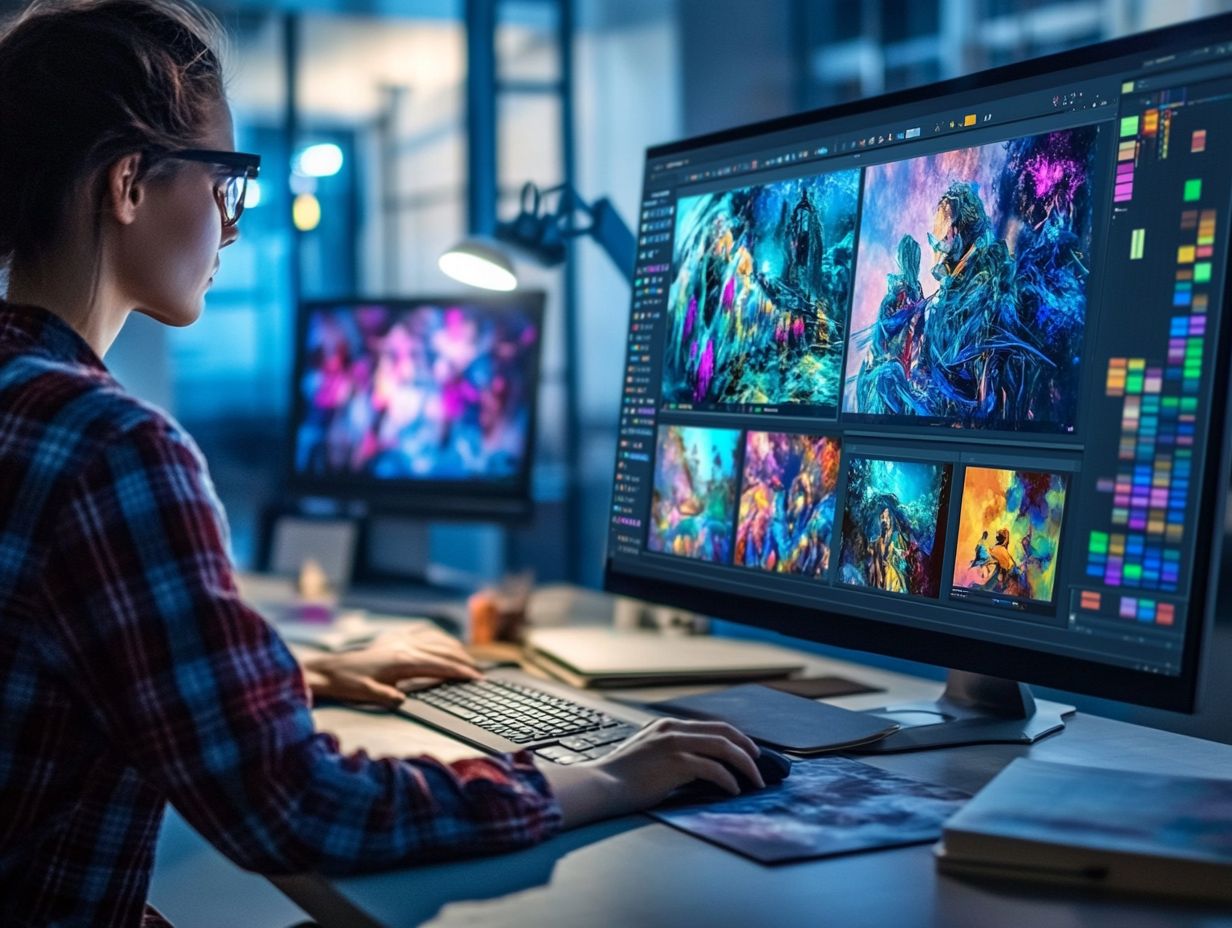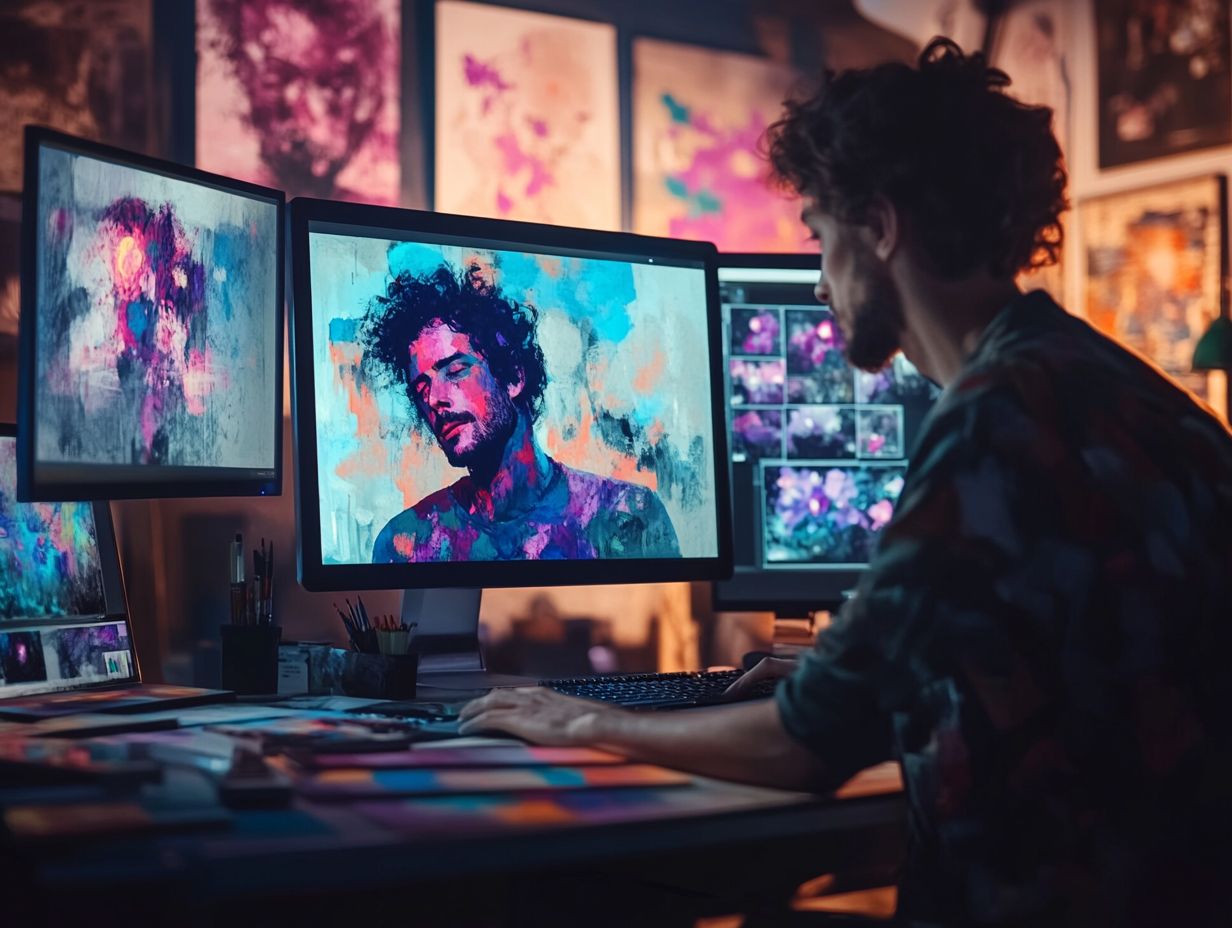In the rapidly evolving realm of generated art, I recognize that **consistency** has become a crucial factor influencing both the quality and perception of the artwork, ensuring **stylistic consistency** and **visual coherence**.
As I delve into the capabilities of **AI image generators**, it is essential for me to understand how consistency is achieved and why it matters. This discussion will examine the intricate interplay between **training data, algorithms**, and **user input** that shapes the art we create through **model training** and **algorithm optimization**.
Additionally, I will explore practical techniques for enhancing **consistency** and **image quality** while addressing the challenges and limitations that artists may encounter. Whether I am an artist eager to leverage new tools or simply someone curious about the technology, this guide aims to provide valuable insights to enrich my understanding of **artistry** and **creative process**.
What is an AI Image Generator?

An AI image generator is a sophisticated tool that utilizes machine learning algorithms and generative models to create images that embody my artistic intent and **artistic style**. These tools employ neural networks to produce artwork that can reflect various artistic styles while maintaining visual fidelity and adhering to specific themes or prompts, all of which I can customize for greater creative control through **prompt engineering**.
By analyzing extensive datasets of images and styles, these systems learn to recognize patterns and nuances, enabling them to **generate output** that not only aligns with my specifications but also inspires new creative directions through **pattern recognition** and **feature extraction**. This application of **generative design** allows me to explore innovative concepts with ease, fostering higher engagement from audiences as they interact with the uniquely generated content, leveraging insights from **data set** analysis.
The output quality of these AI-driven tools often rivals that of traditional artwork, rendering them valuable assets across various fields, including marketing, entertainment, and fine art, demonstrating **image realism** and **graphical fidelity**. As these technologies continue to evolve, the potential for collaboration between users and machines increases, bridging the gap between human creativity and machine proficiency.
The Importance of Consistency in AI Art
Maintaining consistency in AI-generated art is crucial for ensuring that the artistic coherence and visual aesthetics align with my creative intent across various pieces, emphasizing **thematic consistency** and **artistic parameters**. This requires me to uphold a uniform color palette, enhance details, and ensure thematic consistency.
These factors significantly influence user satisfaction and ultimately contribute to the overall quality of the artwork produced by AI tools.
Why Consistency Matters
Consistency is crucial in AI art because it helps me maintain a recognizable art style that resonates with audiences, ultimately leading to more successful artistic expressions.
By concentrating on key artistic features and **coherence metrics**, I can ensure that my generated images are not only visually appealing but also aligned with my overall creative direction, enhancing **image coherence**.
This recognition fosters a deeper connection with viewers, enhancing their overall experience as they begin to expect a certain level of image fidelity and thematic cohesion from my work.
As I explore various artistic approaches, I remain mindful of my signature elements, which serve as guiding principles throughout my creative process. Creative algorithms play a significant role in this journey; they can be fine-tuned to preserve the integrity of my vision while facilitating innovation.
Ultimately, maintaining consistency not only strengthens my artistic identity but also enriches the audience’s encounter with my art, ensuring that it leaves a lasting impression and highlights **creative constraints**.
Factors Affecting Consistency in AI Art

Several factors influence the consistency of my AI-generated art, including the quality of the training data, adjustments made to the algorithm, and the diversity of the dataset utilized, ensuring **output fidelity**.
These elements are crucial to the performance of AI image generators, as they impact how accurately I can replicate artistic styles and maintain visual coherence across various outputs, enhancing **image synthesis**.
Training Data and Algorithms
The training data and algorithm adjustments are critical factors that shape the output of AI image generators, as they directly influence how effectively the system learns and generates images that meet user expectations through **training epochs** and **parameter tuning**. For instance, I find that generative adversarial networks (GANs) depend heavily on diverse datasets to enhance their model selection processes and produce high-quality visual representations through **model fine-tuning**.
The quality of the training data is essential, as it enables the algorithms to recognize patterns and nuances within the artistic styles being emulated, ensuring **similarity search** and **image manipulation**. When the data encompasses a wide range of visual elements, the machine learning methodologies employed can adapt more effectively to generate variations that align with specific artistic criteria.
Additionally, the implementation of feedback loops is significant in refining algorithm performance. These loops allow the system to learn from its past outputs, improving both accuracy and creative alignment with user input through **iterative refinement** and **feedback loops**. This interplay of data quality, diversity, and iterative learning directly contributes to the reliability and consistency of the artwork produced by AI systems.
Human Input and Quality Control
Human input and quality control are essential in ensuring the consistency of AI-generated art, as they refine the creative algorithms used to produce images and enhance **output variability**. By incorporating user feedback into the training process, I can enhance the output variability of AI tools while maintaining artistic coherence and fidelity.
This collaborative approach underscores the importance of human oversight in addressing the artistic challenges that arise during the generation process, ensuring **execution accuracy**. With customized parameters and iterative feedback loops, I am able to influence the creative direction of the AI more effectively, ensuring that the final results align with my artistic vision.
Implementing such quality control measures not only improves the overall quality of the art produced but also significantly enhances user satisfaction, as the artworks generated feel more tailored and reflective of distinct styles.
Ultimately, this fusion of human creativity with algorithmic proficiency paves the way for innovative artistic expressions.
Techniques for Achieving Consistency

Achieving consistency in AI-generated art necessitates a strategic combination of techniques, including the standardization of training data, effective style transfer methods, and advanced image synthesis strategies.
By leveraging these approaches, I can facilitate the creation of images that align with my artistic intent while also ensuring high levels of quality and coherence.
Standardization of Training Data
Standardizing training data is essential for enhancing consistency in AI-generated art, as it ensures that the dataset I use is coherent and representative of the desired artistic styles. I find that employing techniques such as data augmentation and carefully crafted input prompts can significantly contribute to maintaining a consistent output throughout the generation process.
By diversifying datasets to include various artistic genres, I can enable AI systems to draw from a broader palette of influences, ultimately leading to richer and more varied artistic outputs. For example, incorporating a range of paintings, sculptures, and digital art forms can effectively prevent bias and ensure that the generated pieces do not simply replicate a narrow range of styles.
Additionally, feature extraction techniques are pivotal in analyzing the artistic elements present in the training data. This aids the algorithm in discerning patterns and intricacies across different genres, which in turn enhances the overall authenticity and quality of the AI-generated creations.
Utilizing Multiple Algorithms
I find that utilizing multiple algorithms significantly enhances the consistency of AI-generated art. This strategy allows for style experimentation and fine-tuning of performance metrics to align with user expectations.
Not only does this approach provide a broader range of creative options, but it also helps mitigate issues related to output variability and artistic challenges.
By leveraging a diverse set of algorithms, I am able to explore numerous artistic trends that enrich the quality and depth of my work. This exploration facilitates a comparative analysis of performance, demonstrating how different algorithms produce varied output patterns that can more closely align with my desired aesthetic goals.
This synergy between algorithmic versatility and user intention promotes a more refined artistic expression. It enables me to navigate the complexities of modern creative landscapes, resulting in pieces that resonate more strongly with audiences and reflect unique stylistic nuances.
Implementing Quality Control Measures

Implementing quality control measures is essential for ensuring the image fidelity and artistic coherence of AI-generated artworks, enhancing **image attributes** and **image resolution**. This process allows me to identify and correct inconsistencies in the output effectively. My approach includes regular evaluations, gathering user feedback, and adjusting generative parameters to achieve optimal results.
By systematically applying these quality assessment techniques, I can significantly enhance the output quality, ensuring that the resulting images meet artistic standards and resonate with the intended audience, maintaining **contextual relevance**. Strategies such as creating a balanced depth of field within the artwork contribute to a more immersive visual experience.
These practices enable me to identify potential flaws early in the process, which aids in refining the algorithms and techniques I use, ultimately fostering a more consistent and reliable output from AI systems.
In conclusion, this careful orchestration of quality control not only bolsters the credibility of AI art but also elevates the overall creative landscape through enhanced composition and visual harmony.
Challenges and Limitations in AI Image Generation
Despite the advancements in AI image generation tools, I have encountered several challenges and limitations that can affect the consistency of the output and style consistency.
These challenges often arise from factors such as output variability, the complexity of artistic tasks, and the evolving nature of user-defined parameters. These elements can significantly influence the overall quality and coherence of the generated art.
Obstacles to Consistency and Art Direction in AI Art
Obstacles to consistency in AI art frequently stem from the need to reduce randomness in the image generation process, which can result in unpredictable outputs. Challenges in behavior modeling can complicate my understanding of how artistic intent translates into the final artwork, making it difficult to achieve the desired visual coherence.
These factors collectively create an environment where input variability—specifically, the differing training data augmentation sets used for training AI models—can significantly influence artistic trends and overall output patterns.
For artists like myself, this inconsistency often means dealing with unexpected results that diverge from our original vision, leading to additional time spent on refining and editing outputs. Users may also experience disappointment when an algorithm fails to produce a cohesive and recognizable aesthetic, which can undermine their trust in the technology and its creative potential.
These hurdles highlight the necessity for developing more sophisticated systems that can effectively balance creativity with predictability, ensuring that the artistry remains relevant and aligned with user expectations through feature maps and contextual embeddings.
Current Limitations and Future Possibilities in AI Art Generation
Current limitations in AI image generation present both challenges and opportunities for future artistic exploration. As advancements in image synthesis and machine learning continue, I anticipate a greater capacity to overcome existing barriers and enhance the consistency and quality of AI-generated art.
With the emergence of new methodologies like generative adversarial networks (GANs) and diffusion models, the creative potential of AI is set to expand significantly. I believe that artists and designers will be able to harness these tools to explore uncharted territories in visual storytelling, thereby pushing the boundaries of traditional creative workflows.
Through iterative training processes, AI can refine its understanding of style and context, which enables it to produce more nuanced and sophisticated outputs. These developments not only promise exciting possibilities for individual creators but also pave the way for collaborative art forms, where AI partners with human ingenuity.
This partnership fosters a new era of creative exploration that is both thrilling and full of potential, embracing color theory and artistic techniques.
